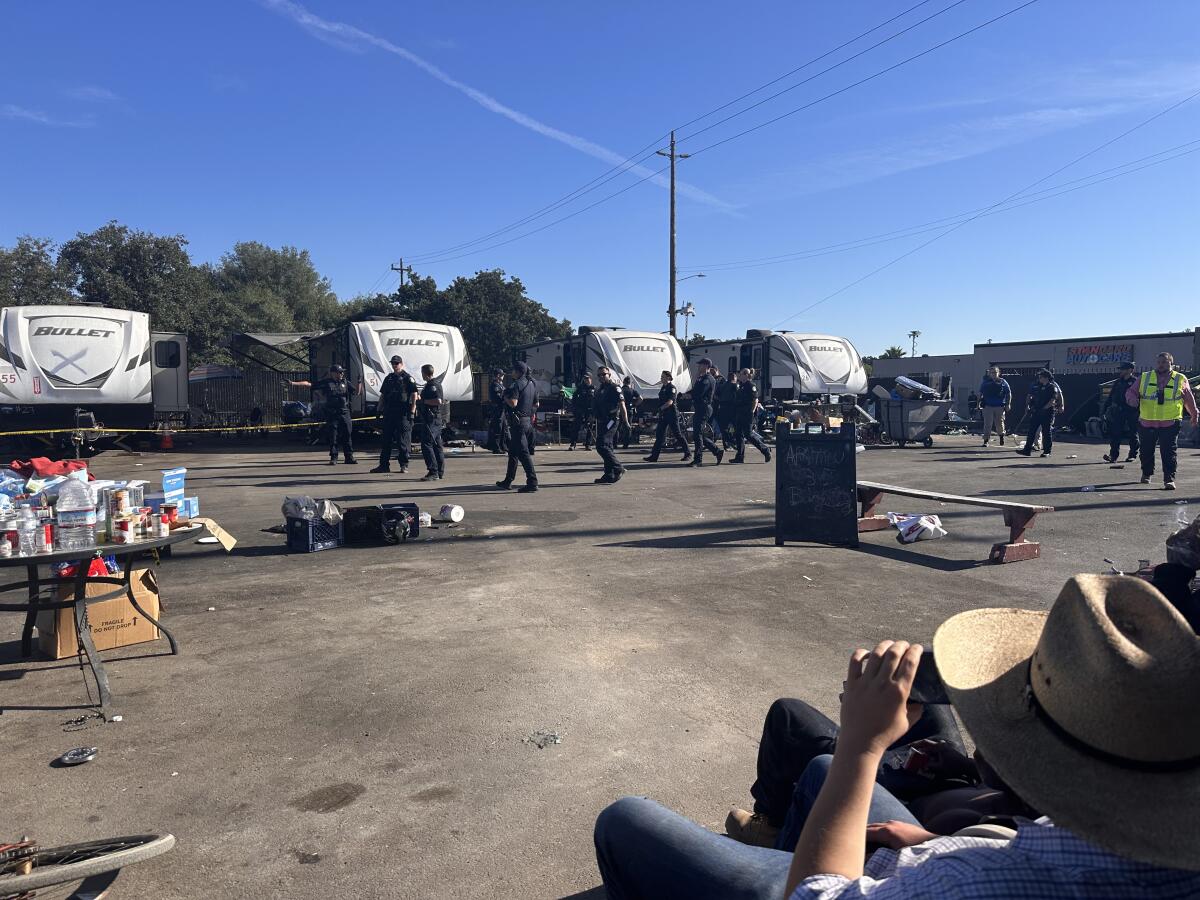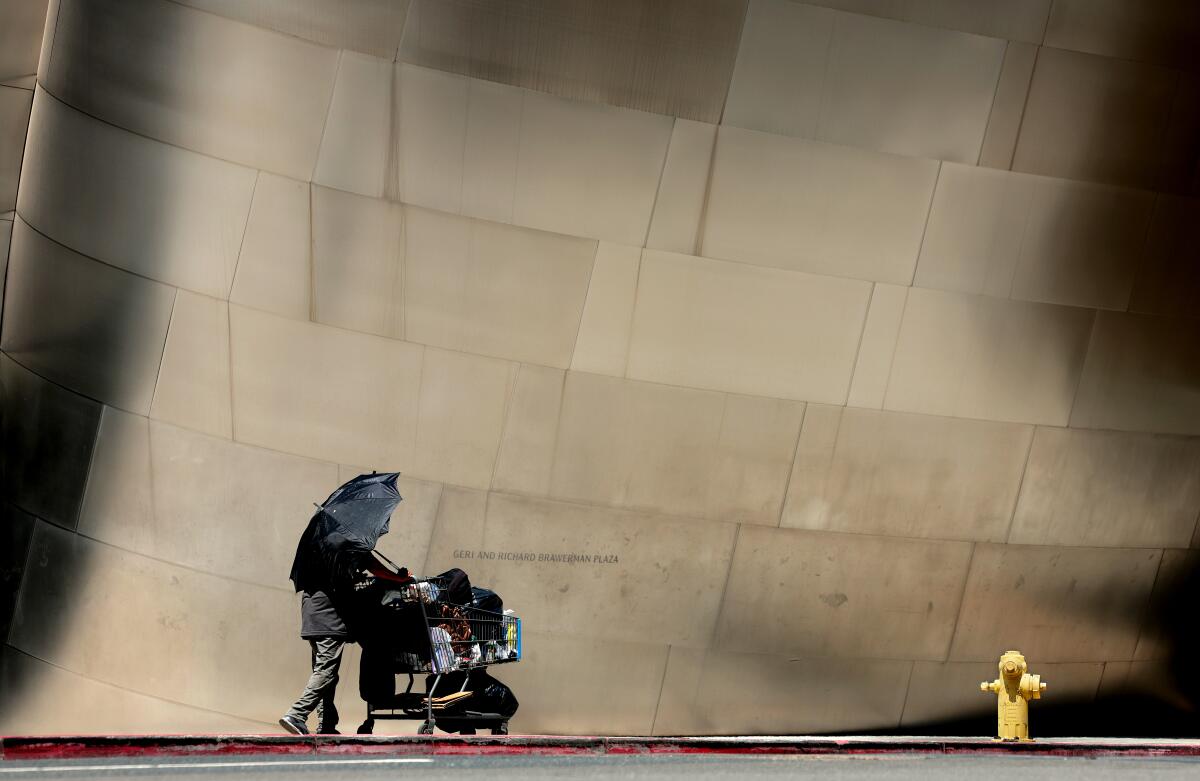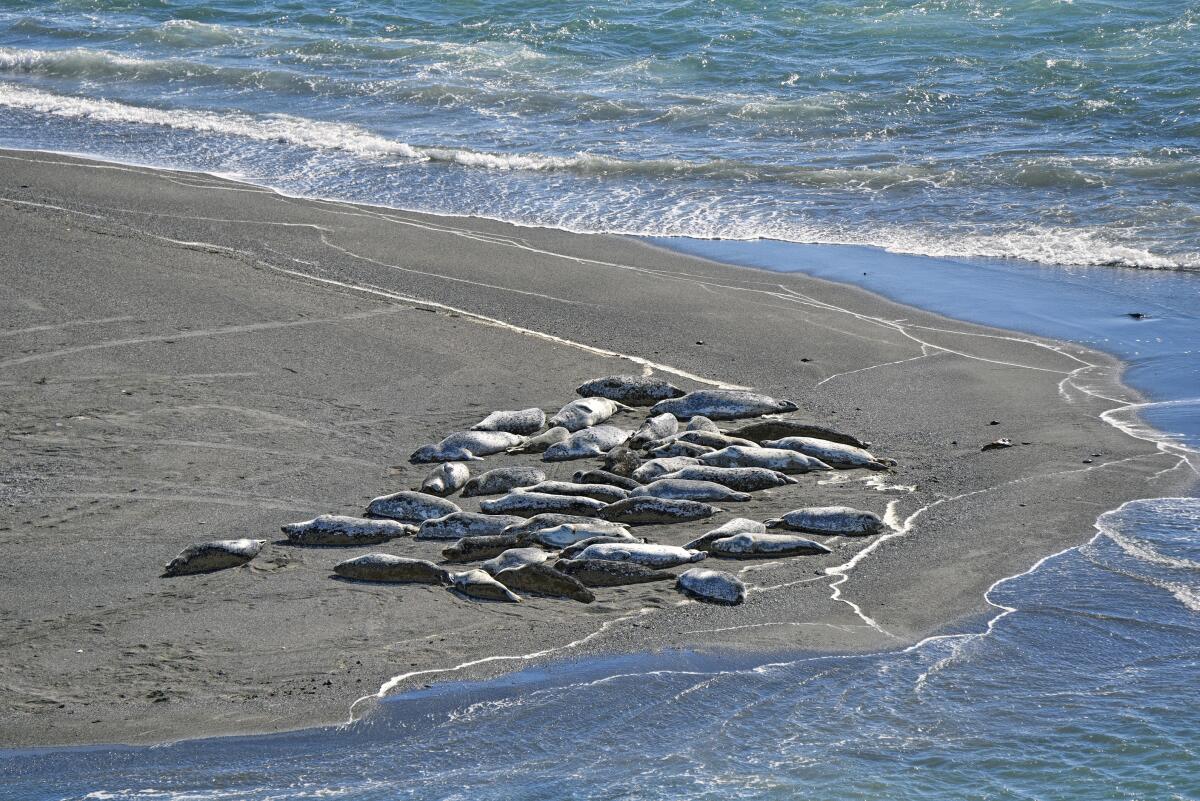Sacramento closed its sanctioned homeless camp, evicting dozens who were promised housing. What happened?

- Share via
Good morning. It’s Tuesday, Sept. 3. Here’s what you need to know to start your day.
- Sacramento swept its city-sanctioned homeless camp. What went wrong with Camp Resolution?
- Parts of Southern California is expected to reach triple-digit temperatures this week.
- A Republican anti-Trump group is launching new swing state ads.
- And here’s today’s e-newspaper
You're reading the Essential California newsletter
Our reporters guide you through our biggest news, features and recommendations every morning
You may occasionally receive promotional content from the Los Angeles Times.
Sacramento’s Camp Resolution hoped to be a national model. Why did the city evict its residents?
When Sacramento officials signed a first-of-its-kind lease with a local nonprofit that allowed unhoused residents to live on city-owned land, local leaders and homeless advocates lauded what they hoped would become a national model.
Dubbed Camp Resolution, the self-governing community of about 50 people — mostly women — fought for a safe haven that would not close until every resident had been placed in “individual permanent durable housing,” as stated in the agreement.
The city provided more than a dozen trailers that had been sitting unused. Local nonprofit Safe Ground Sacramento was responsible for operating the camp, which was self-governed by residents. Unlike the millions it has spent on other shelter sites, the agreement cost the city nothing.
But in August, after roughly 17 months of contention among the city, the nonprofit and a community group that represents the residents, Safe Ground Sacramento moved to terminate the lease. The Sacramento Bee noted that since the camp is on city-owned land and uses city-owned trailers, Sacramento officials could have allowed the residents to stay despite the move by the nonprofit.
Instead, police and other city workers cleared the camp and evicted residents last week, many of whom are older than 55 and living with disabilities. They now face the same conditions they fought for years to avoid.

What happened? That depends on whom you ask.
Safe Ground signed the lease on behalf of Camp Resolution’s residents, but the community was represented by the Sacramento Homeless Union, a local chapter of the National Union of the Homeless. The organization seeks to empower unhoused people to advocate for themselves, rather than rely on nonprofits and government agencies.
That three-party collaboration quickly fractured, with each casting blame elsewhere for breakdowns in communication and cooperation.
“Camp Resolution has proven to be a failed experiment,” city officials wrote in a media release, “largely because of the counterproductive interventions from the Sacramento Homeless Union.”
Officials say the Homeless Union violated lease terms and continuously blocked city workers and social service groups from entering the site. They also accuse advocates of rejecting the city’s efforts to help residents “transition to better shelter and housing options.”
Andrea Henson is the executive director and legal counsel for Where Do We Go?, a nonprofit that advocates against encampment sweeps in the Bay Area. She’s been assisting the Sacramento Homeless Union and said the city’s efforts were rebuffed because they weren’t offering long-term solutions to help people out of homelessness. She accused the city of trying to “destabilize the camp” with its shelter offers.
“You’re negotiating with a collective, not individuals — that’s the whole idea behind being a part of the homeless union. It’s to improve conditions,” she said. “That’s why [residents are] devastated. … They were promised permanent housing — not temporary shelter, not to go into a congregate setting, not to be in a nighttime shelter.”
Representatives of the Homeless Union have accused the city of sabotaging the agreement nearly from the get-go. The city secured permanent housing for just two of the camp’s residents during the camp’s 17-month run, based on the latest available information officials provided. Homeless Union reps say 16 residents found permanent housing working directly with providers.
In a letter to city leaders informing them of plans to terminate the lease, Safe Ground Sacramento Chair Mark Merin said the nonprofit “cannot fulfill its obligations under the lease” and listed a few barriers that he said had undermined the group’s efforts. They included a lack of city assistance to get water and electricity flowing at the site and revising a variance from the local water authority that excludes residents from roughly half the property.
He added that the nonprofit cannot obtain liability insurance and cited concerns that excessive heat and hazardous weather put residents at heightened risk, especially without access to running water and electricity.
In a recent phone interview, Merin also pointed to an “antagonistic approach” by Homeless Union representatives that he said undermined cooperation with the city. He said he floated a plan to relocate the camp to another site and build permanent supportive housing for residents on the leased land, but the union’s representatives wouldn’t go for it.
“We had a good concept going here and unfortunately it’s been ruined,” Merin said. “I feel very bad about that.”
Anthony Prince, lead counsel for the Sacramento Homeless Union, said the group’s resistance came down to the fact that they don’t trust the city and wanted officials to abide by the existing agreement they made to secure permanent housing for residents.
“We’ve learned the hard way that when the city says that they’re going to do something for people and it’s going to be temporary … all that ends up being is a voucher for a few weeks or being shoved into a shelter or maybe a waiting list for Section 8,” Prince previously told me.
Where did camp residents go?
Although the city offered everyone at Camp Resolution alternative shelter, relatively few accepted. According to city officials, 13 people transitioned to city shelters or motels, and one person returned to living with family.
Homeless Union representatives say some residents require generators due to medical conditions, which they can’t bring to the shelter sites the city has offered. Others would have had to surrender pets to animal shelters to comply with site rules.
About 30 former camp residents are still living in the area surrounding the site, according to Crystal Sanchez, Western regional director for the National Union of the Homeless. Some have been robbed and assaulted, she said, and they now face what they fought so hard to avoid: “being flipped from block to block with no real resources.” Still, the group remains resilient.
“The majority of them are staying together because they do have chronic illness,” Sanchez said. “They’ve become a community. They’re a family. It’s about protecting each other at this point.”
What’s next?
The Homeless Union filed emergency motions for relief, but Superior Court Judge Jill Talley denied those requests and canceled a planned hearing last week. Prince said he was considering holding a public forum to correct what he and other Homeless Union leaders say is a false narrative about Camp Resolution and its residents.
Sacramento police declared the camp a crime scene ahead of its sweep. Four people were reportedly cited for resisting and obstructing, but no arrests were made. Reporters from the Sacramento Bee and other news outlets were blocked from the camp, sparking questions about the legality of the move.
Prince also pointed to a recent Supreme Court decision and Gov. Gavin Newsom’s executive order that allow for the clearing of homeless encampments without the stipulation that shelter options be provided.
“I think it emboldened the city to do what they did,” he said.
Prince said the union would continue to help the camp’s former residents and challenged the city’s view that it was a “failed experiment.”
“I think we could have housed everyone because we were cutting out the middleman and we were going directly to housing providers and doing all the necessary paperwork and that entire process to get people housed,” Prince said.
“They’ve torn down a success.”
Today’s top stories

COVID-19 continues to shake California
- Post-Labor Day poses new COVID risk for California. Will the wave get worse?
- The new COVID vaccine is here. Why these are the best times to get immunized.
- Here’s how to keep yourself and others safe from COVID.
Heat waves, fires, landslides...
- A Southern California heat wave is expected to bring temperatures up to 119 degrees.
- Record fire in San Jacinto burns hundreds of acres; 6 firefighters hospitalized.
- Worsening landslide forces power cut to 105 more homes in Rancho Palos Verdes
Tick tock: 63 days until election day
- Republican anti-Trump group to launch new swing state ads.
- Tim Walz unharmed after some vehicles in his motorcade crashed in Milwaukee.
- The team behind the Trump biopic ‘The Apprentice’ talks politics, power and peril.
Grief and fury in Israel
- Strikes and protests roil a divided Israel amid funerals for hostages, including a California native.
- Vigil held for six Israeli hostages, including a California-born man, killed by Hamas.
- U.K. says it’s suspending some arms exports to Israel over the risk of breaking international law.
More big stories
- Has a UC Berkeley chemistry lab discovered the holy grail of plastic recycling?
- ‘Get to know your enemy.’ How Hollywood workers are learning to use AI.
- ESPN, ABC and other Disney channels are dropped from DirecTV in contract dispute.
- A year after ‘hot labor summer,’ California Legislature chills on union demands amid budget concerns.
- Court orders California county to ensure groundwater pumping doesn’t harm streams and fish.
- Will mainstream Californians quit buying gasoline cars?
- California Democrats talked a big game on reparations. They’re off to a slow start.
Get unlimited access to the Los Angeles Times. Subscribe here.
Commentary and opinions
- Anita Chabria: Does Trump know how babies are made?
- Doyle McManus: Trump calls Harris a Marxist, a communist, even a fascist. Why his wild punches don’t land.
- Editorial: Mostly empty mental hospital can help more people — without turning into a jail.
- Robin Abcarian: Why Donald Trump’s politicking at Arlington National Cemetery should disgust every American
- LZ Granderson: What would it mean for Americans if Doug Emhoff became ‘first gentleman’?
- Jackie Calmes: Should a five-time loser with grand juries be president?
- Times editorial board: Which political party is really ‘anti-kid’? Just look at recent child tax credit history
- Guest opinion: Why Black people are overrepresented among L.A.’s homeless population
Today’s great reads

The internet loves this L.A. Chinese herb shop. Can its ancient prescriptions really improve your health? Tian Xiang’s colorful shelves of dried herbs, roots and flowers are meant to cure nearly every imaginable ailment and have drawn many TikTokers in pursuit of alternative medicine.
Other great reads
- Hot, dirty and dangerous: Aerial firefighting is a labor of love.
- After a decade of working in coffee shops, two L.A. filmmakers add an ADU — twice.
How can we make this newsletter more useful? Send comments to essentialcalifornia@latimes.com.
For your downtime

Going out
- 🎼 What’s in store for Dudamel in his last two years with the L.A. Phil? More than it might seem.
- 🍴 The best places to eat and drink in L.A. this month, according to our food writers.
- 🖼️ 8 new pop-ups, drops and exhibitions to fill out your September calendar.
- 🎟️ Are you going to Food Bowl? Here’s what you don’t want to miss.
Staying in
- 📚 30 books to read in the fall.
- 🌱 The biggest — and most expensive — mistakes people make with native plants.
- 🧑🍳 Here’s a recipe for crunchy roast okra with golden labneh.
- ✏️ Get our free daily crossword puzzle, sudoku, word search and arcade games.
And finally ... a great photo
Show us your favorite place in California! We’re running low on submissions. Send us photos that scream California and we may feature them in an edition of Essential California.

Today’s great photo is from Irwin Segel of Davis: the stunning North Coast views in the town of Jenner, where the Russian River meets the Pacific Ocean.
Irwin writes: “The sandy beaches at the river delta have become a nursery for harbor seals. Between March and July, a large colony of seals gathers as the mothers haul out to give birth and raise their young. But the seals can be seen at other times during the year also, albeit in smaller numbers.”
Have a great day, from the Essential California team
Ryan Fonseca, reporter
Defne Karabatur, fellow
Amy Hubbard, deputy editor, Fast Break
Check our top stories, topics and the latest articles on latimes.com.
Sign up for Essential California
The most important California stories and recommendations in your inbox every morning.
You may occasionally receive promotional content from the Los Angeles Times.




